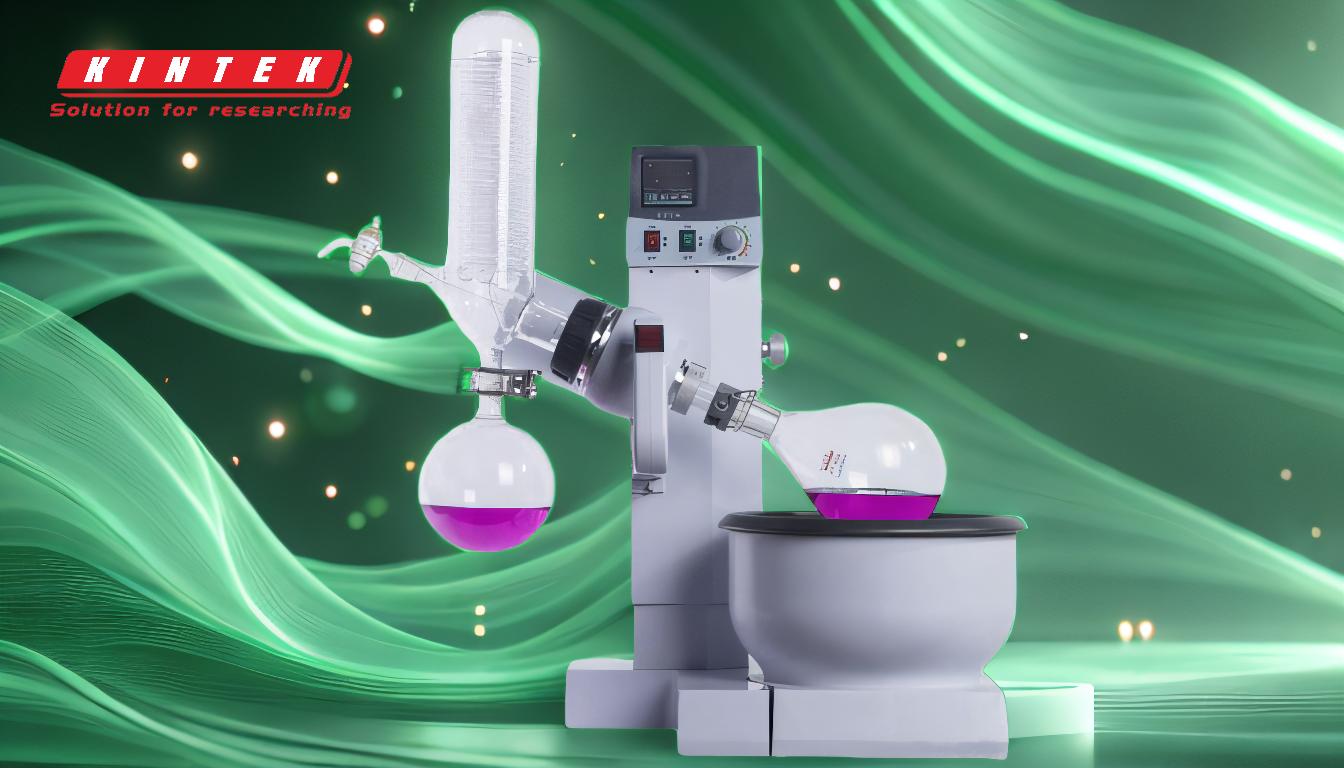A rotary evaporator, often referred to as a "rotovap," is a versatile and essential piece of laboratory equipment used primarily for the efficient and gentle removal of solvents from samples. It is widely employed in various fields, including chemistry, pharmaceuticals, biotechnology, and even molecular gastronomy. The device operates by reducing the pressure to lower the boiling point of solvents, rotating the sample to increase the surface area for evaporation, and heating the solution to facilitate the process. This method is particularly useful for heat-sensitive materials and allows for the recovery of solvents, making it both efficient and cost-effective. Applications range from solvent recovery and concentration to crystallization, drying, and separation, making it indispensable in both research and industrial settings.
Key Points Explained:

-
Primary Function: Solvent Removal
- The rotary evaporator is primarily used to remove volatile solvents from liquid mixtures. This is achieved through a combination of reduced pressure (vacuum), rotation, and controlled heating. By lowering the pressure, the boiling point of the solvent is reduced, allowing it to evaporate at lower temperatures, which is crucial for heat-sensitive compounds.
- Example: In organic chemistry labs, a rotary evaporator is often used to remove solvents like ethyl acetate or n-hexane from reaction mixtures, leaving behind the desired product.
-
Applications in Various Fields
- Pharmaceuticals: Used for the concentration of drug compounds, crystallization of active pharmaceutical ingredients (APIs), and solvent recovery.
- Biotechnology: Employed in the purification and concentration of biomolecules, such as proteins and nucleic acids.
- Chemical Industry: Utilized for the separation and purification of chemical compounds, as well as for solvent recycling.
- Molecular Gastronomy: Used to concentrate flavors and aromas in food without applying excessive heat, preserving the volatile compounds that contribute to taste and smell.
-
Efficiency and Speed
- Rotary evaporators are known for their speed and efficiency in solvent removal compared to traditional methods like evaporation under atmospheric pressure. The rotation of the flask increases the surface area of the liquid, enhancing the rate of evaporation.
- Example: In a lab setting, a rotary evaporator can remove solvents from a sample in minutes, whereas traditional methods might take hours.
-
Heat-Sensitive Applications
- The ability to operate under reduced pressure allows for the gentle removal of solvents, making it ideal for heat-sensitive materials. This is particularly important in biological and medical research, where high temperatures could degrade or denature sensitive compounds.
- Example: In the purification of enzymes or other proteins, a rotary evaporator can be used to remove solvents without exposing the sample to damaging high temperatures.
-
Solvent Recovery
- One of the key advantages of using a rotary evaporator is the ability to recover solvents. This is not only cost-effective but also environmentally friendly, as it reduces the need for disposal of hazardous solvents.
- Example: In industrial settings, solvents like acetone or methanol can be recovered and reused, reducing both costs and environmental impact.
-
Versatility in Processes
- Beyond solvent removal, rotary evaporators are used in various processes such as crystallization, drying, and separation. This versatility makes them a valuable tool in both research and industrial laboratories.
- Example: In the crystallization of a compound, the rotary evaporator can be used to concentrate the solution, promoting the formation of crystals.
-
Limitations and Considerations
- While rotary evaporators are highly effective for low-boiling solvents, they are less efficient for solvents with high boiling points, such as water or dimethylformamide (DMF). In such cases, additional steps like using drying agents or specialized vacuum systems may be required.
- Example: To remove water from a sample, a drying agent like magnesium sulfate (MgSO4) might be used before employing the rotary evaporator.
-
Educational and Teaching Purposes
- Rotary evaporators are also used in educational settings to teach students about evaporation, distillation, and solvent recovery techniques. They provide a hands-on learning experience that is both practical and informative.
- Example: In a university chemistry lab, students might use a rotary evaporator to separate and recover solvents from a mixture, reinforcing their understanding of these fundamental processes.
In summary, the rotary evaporator is a critical tool in modern laboratories, offering a fast, efficient, and gentle method for solvent removal and recovery. Its applications span across various scientific disciplines, making it an indispensable piece of equipment for researchers and industry professionals alike.
Summary Table:
| Key Feature | Description |
|---|---|
| Primary Function | Removes volatile solvents using reduced pressure, rotation, and controlled heat. |
| Applications | Pharmaceuticals, biotechnology, chemical industry, molecular gastronomy. |
| Efficiency | Faster solvent removal compared to traditional methods. |
| Heat-Sensitive Applications | Ideal for heat-sensitive materials like proteins and enzymes. |
| Solvent Recovery | Cost-effective and environmentally friendly solvent recycling. |
| Versatility | Used for crystallization, drying, and separation processes. |
| Limitations | Less effective for high-boiling solvents like water or DMF. |
| Educational Use | Teaches students about evaporation, distillation, and solvent recovery. |
Optimize your lab processes with a rotary evaporator—contact us today to learn more!









